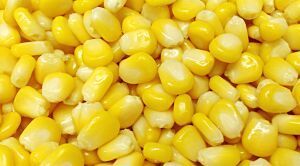
Sweet Corn
Sweet corn is a particular maize species which differ genetically from the field maize. Its kernels are tender, delicious and eaten as a vegetable in many cuisines worldwide. In contrast to the traditional field corn, sweet corn crops are harvested while their corn-ears have just attained the milky stage. The cob either used immediately or frozen for later use since its sugar content turns quickly into starch. Corn is native to the Central Americas which then introduced to the rest of the world through Spanish explorers. Sweetcorn differs genetically from the field maize by mutation at the sugary (su) locus. The crop has achieved a major success as one of the important commercial cash crops in many tropical and semi-tropical countries, incuding the USA. Scientific name: Zea mays var. saccharata. Corn grows to about 7-10 feet in height. It grows quickly under sunny, fertile, and well-drained soil supplanted with good moisture conditions. Each plant bears about 2-6, long husked "ears" filled with rows of tooth-like seeds arranged around a central woody core (cob). Optimum pollination is essential for full kernel development. Several different sweet corn cultivars with variations in their sweetness, color, and maturation are grown keeping in mind of local and regional demands. Most farmers opt for crops that attribute superior eating and keeping quality and high yields. Examples include Standard (su), Sugary Extender (se), Supersweet (sh2), Synergistic (sy), and Augmented Supersweet. Depending on the cultivar type, the crop can be ready for harvesting in 65-90 days. Harvesting is done when the free end (silk end) of the ear is full, its silk has turned brown, and its kernels are firm but in the milky stage. Often, farmers check the kernels by pricking them with their thumbnail to ascertain harvest timing. Baby corns are very young, miniature ears harvested when their kernels are still at the incipient stage. Its central core is sweet and tender enough to be eaten raw. Baby corns measure about 3-5 inches in length and weigh about 20-50 g each. Health benefits of sweet corn At 86 calories per 100 g, sugar corn kernels are moderately high in calories in comparison to other vegetables. However, fresh sweet corn has much fewer calories than that of in the field corn and other cereal grains like wheat, rice, etc. Their calorie chiefly comes from simpler carbohydrates like glucose, sucrose than complex sugars like amylose and amylopectin, which is a case in the cereals. Sweet corn is a gluten-free cereal and may be used safely in celiac disease individuals much like rice, quinoa, etc. Sugar corn features high-quality phytonutrition profile comprising of dietary fiber, vitamins, and antioxidants in addition to minerals in modest proportions. It is one of the finest sources of dietary fibers, 100 g kernels carry 2 g or 5% of daily requirement of dietary fiber. Together with slow digesting complex carbohydrates, dietary fiber in the food helps regulate in a gradual increase in blood sugar levels. However, corn, in line with rice, potato, etc., is one of high glycemic index food items, limiting its authority as the chief food ingredient in diabetes patients. Yellow variety corn has significantly higher levels of phenolic flavonoid pigment antioxidants such as ß-carotenes, and lutein, xanthins and cryptoxanthinpigments along with vitamin-A. 100 g fresh kernels provide 187 IU or 6% of daily requirement of vitamin-A. Altogether; these compounds are required for maintaining healthy mucosa, skin, and vision. Consumption of natural foods rich in flavonoids helps protect from lung and oral cavity cancers. Corn is a good source of the phenolic flavonoid antioxidant, ferulic acid. Several research studies suggest that ferulic acid plays a vital role in preventing cancers, aging, and inflammation in humans. It also contains good levels of some of the valuable B-complex group of vitamins such as thiamin, niacin, pantothenic acid, folates, riboflavin, and pyridoxine. Many of these vitamins function as co-factors to enzymes during substrate metabolism. Further, it contains healthy amounts of some essential minerals like zinc, magnesium, copper, iron, and manganese.
...more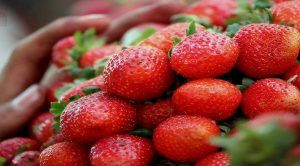
Strawberry
Delicious, rich-red, sweet, yet gently tangy strawberries are among the most popular berries. These berries are native to Europe, however, nowadays cultivated in many temperate regions all over the world as important commercial crops. Botanically, the plant is a low-growing runner (creeper) belonging to the family of Rosaceae, in the genus: Fragaria. In the botany, strawberry described as an aggregate fruit, wherein many one-seeded achenes are coming together to form a large fleshy receptacle. It is a small, low-lying, spreading shrub. It bears small white flowers which eventually develop into small conical, light green, immature fruits. They turn red upon maturity with each berry featuring red pulp with tiny, yellow color seeds piercing from within through its surface. Its top end carries a green leafy cap (calyx with peduncle) that is adorning as a crown. Each berry features conical shape, weighs about 25 grams and measures about 3 cm in diameter. The berries have the taste that varies by cultivar type and ranges from quite sweet to acidic. Although wild varieties are sometimes available in the market, the large-scale production employs the modern "plasticulture" system. In this method, raised beds are formed each year, fumigated, and covered with plastic which prevents growth and crop spoiling. Health benefits of strawberries Strawberry is low in calories (32 cal/100 g) and fats but rich source of health-promoting phytonutrients, minerals, and vitamins that are essential for optimum health. Strawberries have significantly high amounts of phenolic flavonoid phytochemicals calledanthocyaninsand ellagic acid. Scientific studies show that consumption of these berries may have potential health benefits against cancer, aging, inflammation and neurological diseases. Strawberry has an ORAC value(oxygen radical absorbance capacity, a measure of antioxidant strength) of about 3577 µmol TE per 100 grams. Fresh berries are an excellent source of vitamin-C(100 g provide 58.8 mg or about 98% of RDI), which is also a powerful natural antioxidant. Consumption of fruits rich in vitamin-C helps the body develop resistance against infectious agents, counter inflammation and scavenge harmful free radicals. The fruit is rich in the B-complex group of vitamins. It contains good amounts of vitamin B-6, niacin, riboflavin, pantothenic acid and folic acid. These vitamins are acting as co-factors help the body metabolize carbohydrate, proteins, and fats. Strawberries contain vitamin-A, vitamin-E and health promoting flavonoid poly phenolic antioxidants such as lutein, zeaxanthin, and beta-carotene in small amounts. These compounds help act as protective scavengers against oxygen-derived free radicals and reactive oxygen species (ROS) that play a role in aging and various disease processes. Furthermore, They contain a good amount of minerals like potassium, manganese, fluorine, copper, iron and iodine. Potassium is an important component of cell and body fluids that helps controlling heart rate and blood pressure. The human body uses manganeseas a co-factor for the antioxidant enzyme, superoxide dismutase. Copper is required in the production of red blood cells. Iron is esential for red blood cell formation. Fluoride is a component of bones and teeth and offers protection from dental caries.
...more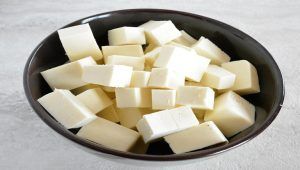
Fresh Cheese Paneer
Paneer is a fresh cheese common in South Asia, especially in Indian, Pakistani, Afghan, Nepali, Sri Lankan, and Bangladeshi cuisines. It is an unaged, acid-set, non-melting farmer cheese or curd cheese made by curdlingheated milk with lemon juice, vinegar, or any other food acids. Its crumbly and moist form is called chhena in eastern India and in Bangladesh.
...more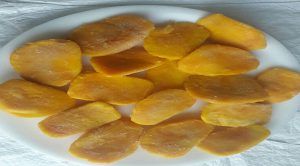
mango slice
The king of the fruits," mango fruit is one of the most popular, nutritionally rich fruits with unique flavor, fragrance, taste, and heath promoting qualities, making it numero-uno among new functional foods, often labeled as “super fruits." Mango is one of the delicious seasonal fruits grown in the tropics. The tree is believed to be originating in the sub-Himalayan plains of the Indian subcontinent. Botanically, this exotic fruit belongs to the family of Anacardiaceae, a family that also includes numerous species of tropical fruiting trees in the flowering plants such as cashew, pistachio. Mango is a tropical tree cultivated in many regions of India, and now its farming has been extended wide across the world in many continents.After flowering, its fruits grow at the end of a long, string-like peduncle, with sometimes more than one fruit to a peduncle. Each fruit measures 5 to 15 cms in length and about 4 to 10 cms in width, and has typical “mango” shape, or sometimes oval or round. Its weight ranges from 150 g to around 750 g. Outer skin (pericarp) is smooth and is green in un-ripe mangoes but turns in ripe fruits into golden yellow, crimson red, yellow or orange-red depending upon the cultivar type. Fresh mango season lasts from April until August. Mango comes in different shapes and sizes depending upon cultivar types. Internally, its flesh (mesocarp) is juicy, orange-yellow in color with numerous soft fibrils radiating from its centrally placed flat, oval-shaped stone (enveloping a single large kidney-shaped seed). Its flavor is pleasant and rich and tastes sweet with a mild tartness. A high-quality mango fruit should feature no or very less fiber composition and minimal tartness. Mango seed (stone) may either has a single embryo or sometimes polyembryonic. Health benefits of Mango fruit Mango fruit is rich in pre-biotic dietary fiber, vitamins, minerals, and poly-phenolic flavonoidantioxidant compounds. According to new research study, mango fruit has been found to protect from colon, breast, leukemia and prostate cancers. Several trial studies suggest that polyphenolic antioxidantcompounds in mango are known to offer protection against breast and colon cancers. Mango fruit is an excellent source of Vitamin-Aand flavonoids like β-carotene, α-carotene,and β-cryptoxanthin. 100 g of fresh fruit provides 765 IU or 25% of recommended daily levels of vitamin-A. Together; these compounds have been known to have antioxidant properties and are essential for vision. Vitamin-A also required for maintaining healthy mucosa and skin. Consumption of natural fruits rich in carotenes is known to protect from lung and oral cavity cancers. Fresh mango is a good source of potassium. 100 g fruit provides 156 mg of potassium while just 2 mg of sodium. Potassium is an important component of cell and body fluids that helps controlling heart rate and blood pressure. It is also an excellent source of vitamin-B6 (pyridoxine), vitamin-C and vitamin-E. Consumption of foods rich in vitamin-Chelps the body develop resistance against infectious agents as well as scavenge harmful oxygen-free radicals. Vitamin B-6 or pyridoxine required for GABA hormone production within the brain. It also controls homocysteine levels within the blood, which may otherwise be harmful to blood vessels resulting in coronary artery disease (CAD), and stroke. Further, it composes moderate amounts of copper. Copper is a co-factor for many vital enzymes, including cytochrome c-oxidaseand superoxide dismutase (other minerals function as co-factors for this enzyme are manganese and zinc). Copper also required for the production of red blood cells. Additionally, mango peelis also rich in phytonutrients, such as the pigment antioxidants like carotenoids and polyphenols.
...more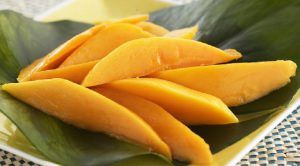
Mango Pulp
The king of the fruits," mango fruit is one of the most popular, nutritionally rich fruits with unique flavor, fragrance, taste, and heath promoting qualities, making it numero-uno among new functional foods, often labeled as “super fruits." Indian subcontinent. Botanically, this exotic fruit belongs to the family of Anacardiaceae, a family that also includes numerous species of tropical fruiting trees in the flowering plants such as cashew, pistachio.Mango is a tropical tree cultivated in many regions of India, and now its farming has been extended wide across the world in many continents.After flowering, its fruits grow at the end of a long, string-like peduncle, with sometimes more than one fruit to a peduncle.Each fruit measures 5 to 15 cms in length and about 4 to 10 cms in width, and has typical “mango” shape, or sometimes oval or round. Its weight ranges from 150 g to around 750 g. Outer skin (pericarp) is smooth and is green in un-ripe mangoes but turns in ripe fruits into golden yellow, crimson red, yellow or orange-red depending upon the cultivar type. Fresh mango season lasts from April until August.Mango comes in different shapes and sizes depending upon cultivar types. Internally, its flesh (mesocarp) is juicy, orange-yellow in color with numerous soft fibrils radiating from its centrally placed flat, oval-shaped stone (enveloping a single large kidney-shaped seed). Its flavor is pleasant and rich and tastes sweet with a mild tartness. A high-quality mango fruit should feature no or very less fiber composition and minimal tartness. Mango seed (stone) may either has a single embryo or sometimes polyembryonic Health benefits of Mango fruit Mango fruit is rich in pre-biotic dietary fiber, vitamins, minerals, and poly-phenolic flavonoidantioxidant compounds. According to new research study, mango fruit has been found to protect from colon, breast, leukemia and prostate cancers. Several trial studies suggest that polyphenolic antioxidant compounds in mango are known to offer protection against breast and colon cancers. Mango fruit is an excellent source of Vitamin-A and flavonoids like β-carotene, α-carotene,and β-cryptoxanthin. 100 g of fresh fruit provides 765 IU or 25% of recommended daily levels of vitamin-A. Together; these compounds have been known to have antioxidant properties and are essential for vision. Vitamin-A also required for maintaining healthy mucosa and skin. Consumption of natural fruits rich in carotenes is known to protect from lung and oral cavity cancers. Fresh mango is a good source of potassium. 100 g fruit provides 156 mg of potassium while just 2 mg of sodium. Potassium is an important component of cell and body fluids that helps controlling heart rate and blood pressure. It is also an excellent source of vitamin-B6 (pyridoxine), vitamin-C and vitamin-E. Consumption of foods rich in vitamin-C helps the body develop resistance against infectious agents as well as scavenge harmful oxygen-free radicals. Vitamin B-6 or pyridoxine required for GABA hormone production within the brain. It also controls homocysteine levels within the blood, which may otherwise be harmful to blood vessels resulting in coronary artery disease (CAD), and stroke. Further, it composes moderate amounts of copper. Copper is a co-factor for many vital enzymes, including cytochrome c-oxidase and superoxide dismutase (other minerals function as co-factors for this enzyme are manganese and zinc). Copper also required for the production of red blood cells. Additionally, mango peel is also rich in phytonutrients, such as the pigment antioxidants like carotenoids and polyphenols.
...more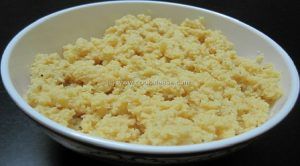
khoa
Khoa is a dairy product widely used in the cuisine of the Indian Subcontinent, encompassing India, Nepal, Bangladeshand Pakistan. It is made of either dried whole milk or milk thickened by heating in an open iron pan. It is lower in moisture than typical fresh cheeses such as ricotta Khoa is used in various types of sweets: Pedha(penda in Gujarati) is sweetened khoa formed into balls or thick disks (like patties) with flavourings such as saffron and/or cardamom added. Gulab jamun, also a round ball sweet made from khoya and then deep fried and soaked in rose water flavoured sugar or honey syrup. A very popular Indian sweet. Barfi(or burfi) is also flavoured, but khoa is not the only ingredient. Typically, another ingredient, such as thickened fruit pulp or coconut shavings, is added to khoya and slow cooked until the moisture evaporates sufficiently to give the consistency of fudge, so it can be flattened and cut into rectangles, parallelograms or diamond shapes. Gujia, a sweet dumpling stuffed with khoa. Halwa is essentially a fudge made by adding khoa to give a dairy-like taste and texture and as a thickening agent
...more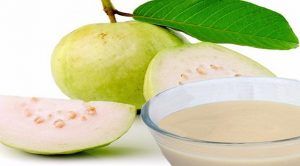
Guava Pulp
Guava is another tropical fruit rich in high-profile nutrients. With its unique flavor, taste, and health-promoting qualities, the fruit easily fits into the category of new functional foods, often labeled as “super-fruits.” It is an evergreen, tropical shrub or small low-growing tree probably originated in the central Americas. Guavas actually thrive well under both humid and dry climates and can tolerate brief periods of cold spells, but can only withstand a few degrees of frost. Its adaptability to ranging environments makes it a favorite commercial crop in some tropical areas. Botanically, this wonderful fruit belongs to the family of Myrtaceae, of the genus: Psidium. Scientific name: Psidium guajava. Health benefits of guava fruit Guava is low in calories and fats but carry several vital vitamins, minerals, and antioxidant polyphenolic and flavonoid compounds that play a pivotal role in the prevention of cancers, aging, infections, etc. The fruit is a very rich source of soluble dietary fiber (5.4 g per 100 g of fruit, about 14% of DRA), which makes it a good bulk laxative. The fiber content helps protect the colon mucosa by decreasing exposure time to toxins as well as binding to cancer-causing chemicals in the colon. Guava-fruit is an excellent source of antioxidant vitamin-C. 100 g fresh fruit provides 228 mg of this vitamin, more than three times the required DRI (daily-recommended intake). Flesh just underneath its thick outer rind composes exceptionally higher levels of vitamin-C than its inner creamy pulp. Scientific studies suggest that regular consumption of fruits rich in vitamin-C helps the human body develop resistance against infectious agents and scavenge cancer causing harmful free radicals from the body. Further, it is essential for collagen synthesis within the body. Collagen is one of the chief structural protein in the human body necessary for maintaining the integrity of blood vessels, skin, organs, and bones. The fruit is a very good source of Vitamin-A,and flavonoids like beta-carotene, lycopene, lutein and cryptoxanthin. The compounds are known to have antioxidant properties and therefore essential for optimum health. Further, is also critical to maintaining healthy mucosa and skin. Consumption of natural fruits rich in carotene is known to protect from lung and oral cavity cancers. 100 g of pink guava fruit provides 5204 µg of lycopene, nearly twice the amount than in tomatoes. (100 g tomato contains 2573 µg of lycopene). Studies suggest that lycopenein pink guavas prevents skin damage from UV rays and offer protection from prostate cancer. Fresh fruit is a very rich source of potassium. It contains more potassium than other fruits like banana weight per weight. Potassium is an important component of cell and body fluids that helps controlling heart rate and blood pressure. Further, the fruit is also a moderate source of B-complex vitamins such as pantothenic acid, niacin, vitamin-B6 (pyridoxine), vitamin E and K, as well as minerals like magnesium, copper, and manganese. The human body uses manganese as a co-factor for the antioxidant enzyme, superoxide dismutase. Copper required for the production of red blood cells.
...more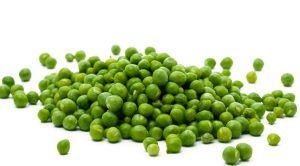
Green Peas
Green peas are one of the most nutritious leguminous vegetables rich in health promoting phytonutrients, minerals, vitamins and antioxidants. Fresh, tender peas are relatively low in calories in comparison to beans, and cowpeas. 100 g of green peas carry just 81 calories and no cholesterol. Nonetheless, they are good sources of protein, vitamins, and soluble as well as insoluble fiber. Fresh pea pods are excellent sources of folic acid. 100 g provides 65 µg or 16% of recommended daily levels of folates. Folates are one of the B-complex vitamins required for DNA synthesis inside the cell. Studies suggest that adequate folate-rich foods when given to expectant mothers would help prevent neural tube defects in their newborn babies. Fresh green peas are healthy sources of ascorbic acid (vitamin-C). 100 g of fresh pods carry 40 mg or 67% of daily requirement of vitamin-C. Vitamin-C is a powerful natural water-soluble antioxidant. Vegetables rich in this vitamin would help the human body develop resistance against infectious agents and scavenge harmful, pro-inflammatory free radicals from the body. Peas contain phytosterols, especially ß-sitosterol. Studies suggest that vegetables like legumes, fruits, and cereals rich in plant sterols help lower cholesterol levels inside the human body. Garden peas are also good in vitamin-K. 100 g of fresh seeds contain about 24.8 µg or about 21% of daily requirement of vitamin K-1 (phylloquinone). Vitamin-K has been found to have a potential role in bone mass building function (mineralization) through the promotion of osteoblastic activity inside the bone cells. It also has an established role in the cure of Alzheimer's disease patients by limiting neuronal damage in the brain. Fresh green peas also carry adequate amounts of antioxidants flavonoids such as carotenes, lutein, and zeaxanthin as well as vitamin-A (provide 765 IU or 25.5% of RDA per 100 g). Vitamin-A is an essential nutrient required for maintaining healthy membranes, skin, and eyesight. Additionally, consumption of natural fruits/vegetables rich in flavonoids helps to protect from lung and oral cavity cancers. In addition to folates, peas are also good in many other essential B-complex vitamins such as pantothenic acid, niacin, thiamin, and pyridoxine. Furthermore, they are a rich source of many minerals such as calcium, iron, copper, zinc, and manganese.
...more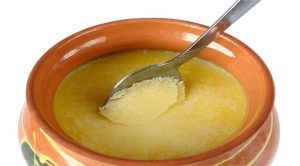
Ghee
Ghee is a class of clarified butter that originated from the Indian subcontinent; and is commonly used in South Asian and Middle Eastern cuisines, traditional medicine, and religious rituals. Ghee is prepared by simmering butter, which is churned from cream, skimming any impurities from the surface, and then pouring and retaining the clear, still liquid fat, while discarding the solid residue that settled on the bottom.[1] Spices can be added for flavor.[2] The texture, color, and taste of ghee depend on the quality of the butter, source of the milk used in the process and the duration of the boiling. Energy 469 kJ (112 kcal)
...more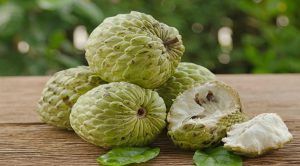
Custard Apple
Custard apple is a delicious, pleasantly fragrant fruit in the Annona family. The fruit is popular for its sweet and slightly tangy, creamy textured flesh. It is also known as bullock's heart in the English speaking countries. Botanically, custard is a "multiple-fruit" wherein the fruit is developed from the merger of several individual flowers (ovaries) into a large fruit mass (infructescence). The custard apple plant is a large shrub belonging to the Annonaceae family. It is native to the tropical rainforests of Central America and naturalized in many parts of the world, spreading along the tropical stretches, from South America to Africa and Asia. Custard apple is a globular, round to heart-shaped fruit with polygonal indentations on its surface. Many cultivars exist, and depending upon the variety there can be green, brown, yellow, maroon fruits. Custard apple features tough, outer skin. Inside, individual arils consist of cream-white sheath enveloping single, glossy, deep brown color seeds. The flesh just underneath its surface has a granular texture. Skin and seeds are inedible and discarded. Its flavor described as a reminiscence of mangosteen, sweet and pleasantly tangy, melts inside the mouth. Custard apple is smaller in size than cherimoya (A. cherimola), Pond apple (A. glabra) and soursop (A. muricata) but a bit larger than sugar apple (A. squamosa). Oftentimes, Sugar apple is termed interchangeably to custard apple. Health benefits of custard apple Custard apple has relatively more calories than cherimoya. 100 g of the fruit carries 101 calories against 56 calories of cherimoya. The major portion of the calorie comes from simple carbohydrates. It, however, contain no saturated fats or cholesterol. As in other Annona family fruits, custards also contain several polyphenolic antioxidants. Among them, the most prominent are Annonaceous acetogenins. Acetogenin compounds such as asimicinand annonacin are potent cytotoxins. These compounds have been found to have anti-cancer, anti-malarial and de-worming properties. Custards compose of more vitamin-C(19.2 mg/100 g) than that of in cherimoya. Sugar-apples, however, carry the highest (36.3 mg/100 g) amount of this vitamin among all the Annona fruits. Vitamin-C is a powerful natural antioxidant. Consumption of fruits rich in vitamin-C helps the human body develop resistance against infectious agents and scavenge harmful, pro-inflammatory free radicals from the body. Custard apple is a modest source of B-complex vitamins, especially vitamin B-6 (pyridoxine, 17% per 100 g)). Pyridoxine helps keep up GABA neurochemical in the brain. High GABA levels in the blood help calm down nervous irritability, tension, and headache ailments. Custards contain minerals such as calcium, copper, magnesium, iron (9% of RDI per 100 g) and manganese. Additionally, they compose more potassium (382 mg per 100 g) than cherimoya (287 mg per 100 g).
...moreBe first to Rate
Rate ThisOpening Hours